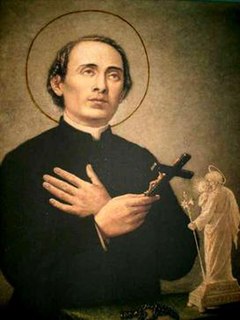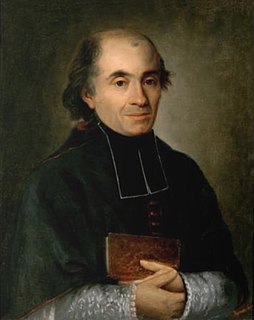Related Research Articles

Filippo Smaldone was an Italian Roman Catholic priest and the founder of the Salesian Sisters of the Sacred Hearts. Smaldone is best known for his extensive work with the deaf during his lifetime. Smaldone was a gifted preacher known for his commitment to proper catechesis and to the care of orphans and the mute, which earned him civic recognition.

Johannes Ludovicus Paquay, also known as Valentinus, was a Belgian Roman Catholic priest and a professed member from the Order of Friars Minor. He was a popular confessor and noted preacher while serving in various leadership positions in the house he was stationed in; he was also known for his popular devotion to the Eucharist and the Sacred Heart and promoted these devotions to the faithful and to his conferees alike.

Alain de Solminihac was a French Roman Catholic religious reformer and served as the Bishop of Cahors from 1636 until his death.

Nazju Falzon was a Maltese cleric and a professed member from the Secular Franciscan Order. He did not become an ordained priest because he did not feel he was adequate enough for such an honor. He became an apt catechist and noted for his commitment to religious instruction.

Manuel González García was a Spanish bishop of the Roman Catholic Church who served as the Bishop of Palencia from 1935 until his death. He was also the founder of the Eucharistic Missionaries of Nazareth and also established both the Disciples of Saint John and the Children of Reparation. He was known for his strong devotion to the Eucharist and became known as the "Bishop of the Tabernacle" due to this devotion; he made it an objective of his to spread devotion to the Eucharist and encouraged frequent reception of it.

Pierre Vigne was a French Roman Catholic priest who established the Blessed Sacrament Sisters of Valence.
Edoardo Giuseppe Rosaz was an Italian Roman Catholic prelate who served as the Bishop of Susa from 1877 until his death and was the founder of the Franciscan Mission Sisters of Susa. He was appointed a bishop at the suggestion of John Bosco. His apostolic zeal became even greater as a bishop when he tended to abandoned people in the peripheries and encouraged the work of a range of different religious orders.

Alcide-Vital Lataste, OP was a French Catholic priest of the Dominican Order. He established the Dominican Sisters of Bethany in 1867 in order to work with women who were abused or from prisons. Their aim was to spread the merciful love of Jesus Christ to these women. He assumed the name of Jean-Joseph after he entered the Dominican order.
Francesco Paleari was an Italian priest and a member of the Society of the Priests of Saint Giuseppe Benedetto Cottolengo. He was a noted preacher and was involved in the work of social services to the poor.

Giuseppe Nascimbeni was an Italian Roman Catholic priest who exercised his pastoral mission in his home of Verona and who also established the Little Sisters of the Holy Family.

Pierre Bonhomme was a French Roman Catholic priest who exercised his pastoral mission in Cahors. He went on to establish the new religious congregation known as the Sisters of Our Lady of Calvary of Gramat.

Luigi Biraghi was an Italian Roman Catholic priest who served in his home of Milan. Biraghi later went on to establish his own religious congregation known as the Sisters of Saint Marcellina.

Florentino Asensio Barroso was a Spanish Roman Catholic who served as the Apostolic Administrator of the Diocese of Barbastro. He served as a chaplain of both the Little Sisters of the Poor and the Servants of Jesus as a priest. He was elevated into the episcopate in 1935 and was killed in 1936 during the onslaught of the Spanish Civil War.

Federico Albert was an Italian Roman Catholic priest. He established the Vincentian Sisters of Mary Immaculate - also known as the Albertines - and he established this order in order to work with the poor of Turin.
Giuseppe Allamano was an Italian Roman Catholic priest. He established the Consolata Missionaries (I.M.C.) congregation for males and another for females, known as the Consolata Missionary Sisters. Allamano also served as the rector of the Santuario della Consolata and transformed the shrine into a source of spiritual renewal for the faithful.

Luigi Variara was an Italian Roman Catholic priest and a professed member of the Salesians of Don Bosco. He served for most of his life as part of the missions in Colombia where he worked with lepers and the children of outcast lepers. He was ordained as a priest while serving there and made it his mission to provide both relief and consolation.

Pietro Bonilli was an Italian Roman Catholic priest and the founder of the Sisters of the Holy Family of Spoleto. Bonilli served as a diocesan priest for his entire life in both Trevi and Spoleto while using his order to reach out to orphans and homeless people.
Giovanni Maria Boccardo was an Italian Roman Catholic priest, brother of Luigi Boccardo, and the founder of the Poor Daughters of Saint Cajetan. Boccardo tended to victims of a cholera epidemic in 1884 and was forced to resign all positions in his parish in 1911 due to illness that confined him to his bed. He was the elder brother of Blessed Luigi Boccardo.
Marcantonio Durando was an Italian Roman Catholic priest and a professed member of the Congregation of the Mission in an effort to follow the teachings of Vincent de Paul - an ardent focus of his life and pastoral career. Durano was also the founder of the Daughters of the Passion of Jesus the Nazorean (1865) - or Nazarene Sisters - and founded that order with the assistance of Luigia Borgiotti (1802-1873).
Mariano da Roccacasale - born Domenico di Nicolantonio - was an Italian Roman Catholic professed religious from the Order of Friars Minor. He was of peasant stock and entered the order in his twenties as a professed religious rather than as an ordained priest. He was an influence in the decision of Giuseppe Oddi joining the Franciscans after their 1863 encounter.
References
- 1 2 3 "Blessed Clemente Marchisio". Saints SQPN. 9 April 2015. Retrieved 2 March 2016.
- 1 2 3 4 5 "Blessed Clemente Marchisio, December 16". The Black Cordelias. 16 December 2008. Retrieved 2 March 2016.
- 1 2 3 "Blessed Clemente Marchisio". Santi e Beati. Retrieved 2 March 2016.